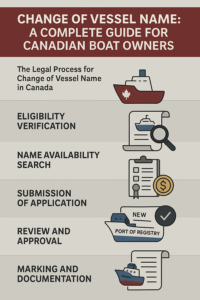Changing the name of a registered ship in Canada seems simple, but it is a legal and administrative process. Transport Canada governs this process under the Change of Vessel Name procedure. This procedure ensures that registered ships always have a consistent, traceable and complete set of records. It is important to understand this process for retaining registration, either when re-registering a commercial vessel or when naming a new private yacht.
A registered vessel’s name is considered part of the vessel’s official name identifying ownership, history, and port of registry. To avoid confusion, duplicated names, or failure to comply with the National Vessel Registry system’s requirements, any registered name change must first be approved before taking effect.
Understanding the Importance of a Vessel’s Official Name
Under the authority of the Canada Shipping Act, 2001, the name of a vessel creates a legal connection between its ownership, its registration, and its port of registry. In Canada, in order to Change Of Vessel Name, approval from Transport Canada is required to ensure the absence of duplicates.
| Aspect | Before Name Change | After Name Change |
|---|---|---|
| Registered Name | Existing official name on record | Approved new name |
| Certificate of Registry | Must be updated | Reissued with new details |
| Port of Registry | Remains unchanged unless transferred | Optional change |
| Operational Identity | Existing identification maintained | New name applied to all records |
Why Vessel Naming Matters – Change Of Vessel Name
- Legal Recognition: A vessel’s name is associated with its registration and ownership information.
- International Identification: Allows traceability within international maritime information systems.
- Operational Clarity: Aids in avoiding duplication or fraud in shipment.
- Cultural or Personal Importance: Many owners will also change the vessel name for cultural or personal reasons.
If government vessels and commercial vessels change names, the changes may affect permits, insurance, or licenses so they must change the name properly.
The Legal Process for Change of Vessel Name in Canada
Name changes for vessels require multiple steps under Transport Canada’s National Vessel Registry Center.

Eligibility Verification
Register the vessel under the Canadian flag before you rename it. The registered owner must be the legal owner and all title documents (mortgages, liens, etc.) should be in good standing.
Name Availability Search
Transport Canada maintains a database to avoid duplication in name. Applicants must provide up to three preferred names, and authorities immediately reject any duplicate or misleading name.
Submission of Application
Owners must submit an Application for Change of Vessel Name and/or Transfer of Port of Registry and the following documents application documentation:
- Current Certificate of Registry
- Proof of ownership (bill of sale or registry extract)
- Application fee payment
Review and Approval
Transport Canada then simply reviews the name through the lens of the naming conventions to ensure it meets the criteria, and issues a new Certificate of Registry.
Marking and Documentation
The owners have to repaint/reentered the new name and port of registry on the hull. You must record the new name in logbooks, insurance documents, and licenses, and register the official number.
Yours is now going to be compliant and in operation, under a brand new identity.
Legal Regulations Governing Change Of Vessel Name
Name Uniqueness and Approval
Under Canadian maritime law, the name of a vessel must be unique as, to the extent possible, to avoid confusion in registration and communications, and may be rejected by Transport Canada if deemed unsuitable.
Prohibited Names
Certain names are off-limits:
- Those containing offensive language.
- Names identical or confusingly similar to existing vessels.
- Falsely implying government affiliation or endorsement.
Obligations After Name Change
After the change, the owner must ensure that:
- The old name is removed from the vessel hull.
- The new name and port of registry are in block letters.
- Navigation and communication systems use the updated name.
Updating Associated Records
Owners must notify their insurers, charter agencies, the Panama Canal Authority and port authorities.
Not meeting requirements can cause administrative penalties or registration suspension.
Processing Time Comparison for Vessel Documentation Changes
- Name Change processes are the fastest, with an average processing time of 10 days.
- Port Transfer takes longer—about 12 days—because the team must complete additional manual validation.
- Full Re-registration is the slowest, taking up to 20 days due to substantial document verification.
Commercial Vessel Name Change
After the shipping company serving the coast of British Columbia changed the name of their ship “Coastal Breeze” to “Ocean Voyager” to match their new corporate identity.
Process Summary:
- Conducted a name availability search.
- Submitted a complete application to Transport Canada.
- Updated insurance, charter licenses, and hull markings.
- A new Certificate of Registry was issued within ten days.
Outcome:
Even with the change in its fleet branding, the company remained compliant without any downtime.
An orderly approach enables smooth renaming of vessels.
Best Practices for Changing a Vessel Name
Renaming a vessel is an act including both practical and symbolic implications. Here are some best practices.
- Verify Name Uniqueness Early: Before finalizing a name, check Transport Canada’s corporate name search.
- Use Professional Services: Consider hiring documentation professionals to avoid delays or mistakes.
- Update Insurance and Licenses: Notify your insurance provider and port authorities when coverage changes.
- Preserve Historical Records: Photocopies of the old certificate should be kept for documentary purposes.
Such practices can ensure a more orderly transition from one vessel identity to another.
Common Challenges and How to Overcome Them
| Action Step | Purpose | Outcome / Importance |
|---|---|---|
| Conduct name search | Avoid duplication or rejection | Ensures the new name is unique and acceptable to authorities |
| Submit accurate forms | Prevent administrative delays | Helps expedite approval and record updates |
| Update vessel markings | Ensure legal compliance | Reflects the approved name on all physical identifiers |
| Notify third parties | Maintain operational transparency | Keeps insurers, ports, and partners informed of changes |
Delayed Documentation
Most application issues involve incomplete forms and missing documents. Review your application for ensuring it is complete.
Outdated Vessel Markings
Failure to promptly update the hull or registration documents may result in penalties during boat inspections.
Record Inconsistency
Other documents, such as insurance, licenses, and port records should be in the name of the new vessel.
These actions allow owners to avoid complications, and to operate without interruption.
Why the Process Matters for Maritime Compliance
Maintaining the integrity of the public record of the Change of Vessel Name process also provides compliance with national marine safety policies for a complete list of vessels operating in Canada.
Benefits of Proper Vessel Name Registration
- Operational Clarity: Clear identification simplifies navigation and communication.
- Legal Protection: Provides defensible ownership in case of disputes.
- International recognition: foreign waterways recognized consistently.
- Safety Compliance: Avoids confusion during distress calls, inspections, or emergencies.
Navigating a Smooth Change Of Vessel Name
The Change of Vessel Name process is a critical administrative and legal step. It ensures your vessel remains compliant, traceable, and operational under its new name. Knowledge of the documents, rules, and duties at hand can help people avoid errors and move the approval procedure forward.
If you rename, personalize, or transfer ownership in an organization, registering at National Vessel Registry Center makes the transition smooth.

